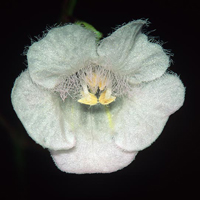Skinner’s agalinis
Scientific name: Agalinis skinneriana

Cover photo credit: Allen Woodliffe
Status
Endangered
“Endangered” means the species lives in the wild in Ontario but is facing imminent extinction or extirpation.
Date added to the Species at Risk in Ontario List
The Skinner’s agalinis was already assessed as endangered when the Endangered Species Act took effect in 2008.
Read the Assessment Report
What it looks like
Skinner’s agalinis is an annual flowering plant that grows five to 35 centimetres tall in its Canadian range. The stem is pale green and may have a few branches near the top. The leaves are more or less opposite, stemless and tiny, growing to 20 millimetres in length and only two millimetres wide at most.
The plant produces white to very pale pink, tube-shaped flowers that divide into five broadly triangular lobes, the lower three occasionally marked with purple spots and yellow lines. Flowers bloom in late summer. The seedpods are round and contain many tiny brownish-yellow triangular seeds.
Skinner’s agalinis is partially parasitic on other plants, receiving some water and nutrients from a host plant, but able to produce some of its own energy from the sun.
Where it lives
Skinner’s agalinis only grows in tallgrass prairie habitats in Ontario, an extremely rare ecosystem in the province.
It probably has a range of host species, but the only confirmed connection is to the prairie grass, Little bluestem (Schizachyrium scoparium).
Where it’s been found in Ontario
Skinner’s agalinis is rare throughout its range in central North America which extends from extreme southwestern Ontario, west to Indiana, Minnesota and Kansas.
In Canada, it is found only in southwestern Ontario – on two islands in the St. Clair River delta, at Lake St. Clair, and also in a small prairie near Windsor.
What threatens it
The main threat to Skinner’s agalinis is habitat destruction and alteration.
It is also threatened by fire suppression and changes in water levels, and likely by competition from invasive plants such as White sweet clover (Melilotus alba), European common reed (Phragmites australis spp. australis), Canada thistle (Cirsium arvense) and Scots pine (Pinus sylvestris).
Action we are taking
Endangered Species and their general habitat are automatically protected.
Recovery strategy
A recovery strategy advises the ministry on ways to ensure healthy numbers of the species return to Ontario.
Read the Executive Summary and Full Document (January 28, 2016)
Government response statement
A government response statement outlines the actions the government intends to take or support to help recover the species.
Read the government response statement (October 28, 2016)
Review of progress
A review of progress made toward protecting and recovering a species is required no later than the time specified in the species’ government response statement, or not later than five years after the government response statement is published if no time is specified.
Read the report on progress towards the protection and recovery of 18 species at risk, including Skinner’s Agalinis (2021).
Habitat protection
General Habitat Protection - June 30, 2008
What you can do
Report a Sighting
The Ministry of Natural Resources and Forestry tracks species at risk such as the Skinner’s agalinis. Report a sighting of an endangered animal or plant to the Natural Heritage Information Centre. Photographs with specific locations or mapping coordinates are always helpful.
Volunteer
Volunteer with your local nature club or provincial park to participate in surveys or stewardship work focused on species at risk.
Be a good steward
- private land owners have a very important role to play in species recovery; if you find Skinner’s agalinis on your land, you may be eligible for stewardship programs that support the protection and recovery of species at risk and their habitats
- invasive species seriously threaten many of Ontario’s species at risk; to learn what you can do to help reduce the threat of invasive species, visit:
- Skinner’s agalinis and many other species at risk depend on healthy grassland prairies, a rare habitat in Ontario; learn more about these habitats, the species that depend on them, and what you can do to help at:
www.tallgrassontario.org.
Report illegal activity
Report any illegal activity related to plants and wildlife to
Quick facts
- Skinner’s agalinis is able to steal nutrients from other plants; it uses a fungus to attach its own roots to the roots of its host plant, and is then able to leech nutrients and water out of the plant
- Skinner’s agalinis only grows in tallgrass prairie in Canada, which is one of the most endangered habitats in Ontario; this extremely rare community supports an amazing diversity of life, including over 500 species of plants
- fire plays an important role in maintaining the prairie habitat of Skinner’s agalinis by naturally removing trees, shrubs, and many invasive plants that can shade-out the sun-loving prairie plants